Edible mushroom
Edible mushrooms are the fleshy and edible fruit bodies of several species of fungi.Mushrooms belong to the macrofungi, because their fruiting structures are large enough to be seen with the naked eye. They can appear either below ground (hypogeous) or above ground (epigeous) where they may be picked by hand.[1] Edibility may be defined by criteria that include absence of poisonous effects on humans and desirable taste and aroma.[2][3]
Edible mushrooms are consumed by humans as comestibles for their nutritional value and they are occasionally consumed for their supposed medicinal value. Mushrooms consumed by those practicing folk medicine are known as medicinal mushrooms. While hallucinogenic mushrooms (e.g. Psilocybin mushrooms) are occasionally consumed for recreational or religious purposes, they can produce severe nausea and disorientation, and are therefore not commonly considered edible mushrooms.[4]
Edible mushrooms include many fungal species that are either harvested wild or cultivated. Easily cultivatable and common wild mushrooms are often available in markets, and those that are more difficult to obtain (such as the prized truffle and matsutake) may be collected on a smaller scale by private gatherers. Some preparations may render certain poisonous mushrooms fit for consumption.
Before assuming that any wild mushroom is edible, it should be identified. Proper identification of a species is the only safe way to ensure edibility. Some mushrooms that are edible for most people can cause allergic reactions in some individuals, and old or improperly stored specimens can cause food poisoning. Deadly poisonous mushrooms that are frequently confused with edible mushrooms and responsible for many fatal poisonings include several species of the Amanita genus, in particular, Amanita phalloides, the death cap. Mushrooms growing in polluted locations can accumulate pollutants such as heavy metals.[5]
Current culinary use[edit]
Mycophagy /maɪˈkɒfədʒi/, the act of consuming mushrooms, dates back to ancient times. Edible mushroom species have been found in association with 13,000 year old ruins in Chile, but the first reliable evidence of mushroom consumption dates to several hundred years BC in China. The Chinese value mushrooms for medicinal properties as well as for food. Ancient Romans and Greeks, particularly the upper classes, used mushrooms for culinary purposes.[4] Food tasters were employed by Roman Emperors to ensure that mushrooms were safe to eat.[6]
Mushrooms are also easily preserved, and historically have provided additional nutrition over winter.[citation needed]
Many cultures around the world have either used or continue to use psilocybin mushrooms for spiritual purposes as well as medicinal mushrooms in folk medicine.
A fraction of the many fungi consumed by humans are currently cultivated and sold commercially. Commercial cultivation is important ecologically, as there have been concerns of depletion of larger fungi such as chanterelles in Europe, possibly because the group has grown so popular yet remains a challenge to cultivate.
Commercially cultivated[edit]
Mushroom cultivation has a long history, with over twenty species commercially cultivated. Mushrooms are cultivated in at least 60 countries[7] with China, the United States,Netherlands, France and Poland being the top five producers in 2000.
Commercially harvested wild edibles[edit]
Some species are difficult to cultivate; others (particularly mycorrhizal species) have not yet been successfully cultivated. Some of these species are harvested from the wild, and can be found in markets. When in season they can be purchased fresh, and many species are sold dried as well. The following species are commonly harvested from the wild:
- Boletus edulis or edible Boletus, native to Europe, known in Italian as Fungo Porcino(plural 'porcini') (Pig mushroom), in German as Steinpilz (Stone mushroom), in Russian as "white mushroom", in Albanian as (Wolf mushroom) and in French the cèpe. It also known as the king bolete, and is renowned for its delicious flavor. It is sought after worldwide, and can be found in a variety of culinary dishes.
- Cantharellus cibarius (The chanterelle), The yellow chanterelle is one of the best and most easily recognizable mushrooms, and can be found in Asia, Europe, North America and Australia. There are poisonous mushrooms which resemble it, though these can be confidently distinguished if one is familiar with the chanterelle's identifying features.
- Cantharellus tubaeformis, the tube chanterelle or yellow-leg
- Clitocybe nuda - Blewit (or Blewitt)
- Cortinarius caperatus the Gypsy mushroom (recently moved from genus Rozites)
- Craterellus cornucopioides - Trompette de la Mort or Horn of Plenty
- Grifola frondosa, known in Japan as maitake (also "hen of the woods" or "sheep’s head"); a large, hearty mushroom commonly found on or near stumps and bases of oak trees, and believed to have Macrolepiota procera properties.
- Gyromitra esculenta this "False morel" is prized by the Finns. This mushroom is deadly poisonous if eaten raw, but highly regarded when parboiled (see below).
- Hericium erinaceus, a tooth fungus; also called "lion's mane mushroom."
- Hydnum repandum Sweet tooth fungus, hedgehog mushroom, urchin of the woods
- Lactarius deliciosus Saffron milk cap - Consumed around the world and prized in Russia
- Morchella species, (morel family), morels belong to the ascomycete grouping of fungi. They are usually found in open scrub, woodland or open ground in late spring. When collecting this fungus, care must be taken to distinguish it from the poisonous false morels, including Gyromitra esculenta.
- Morchella conica var. deliciosa
- Morchella esculenta var. rotunda
- Tricholoma matsutake the Matsutake, a mushroom highly prized in Japanese cuisine.
- Tuber species, (the truffle), Truffles have long eluded the modern techniques of domestication known as trufficulture. Although the field of trufficulture has greatly expanded since its inception in 1808, several species still remain uncultivated. Domesticated truffles include
- Tuber borchii
- Tuber brumale
- Tuber indicum - Chinese black truffle
- Tuber macrosporum - White truffle
- Tuber mesentericum - The Bagnoli truffle[8]
- Tuber uncinatum - Black summer truffle
Other edible wild species[edit]
Many wild species are consumed around the world. The species which can be identified "in the field" (without use of special chemistry or a microscope) and therefore safely eaten vary widely from country to country, even from region to region. This list is a sampling of lesser-known species that are reportedly edible.
- Amanita caesarea (Caesar's Mushroom)
- Armillaria mellea
- Boletus badius
- Chroogomphus rutilus (pine-spikes or spike-caps)
- Calvatia gigantea (Giant Puffball)
- Clavariaceae species (coral fungus family)
- Clavulinaceae species (coral fungus family)
- Coprinus comatus, the Shaggy mane. Must be cooked as soon as possible after harvesting or the caps will first turn dark and unappetizing, then deliquesce and turn to ink. Not found in markets for this reason.
- Cortinarius variicolor
- Fistulina hepatica (beefsteak polypore or the ox tongue)
- Hygrophorus chrysodon
- Lactarius salmonicolor
- Lactarius subdulcis (mild milkcap)
- Lactarius volemus
- Laetiporus sulphureus (Sulphur shelf). Also known by names such as the "chicken mushroom", "chicken fungus", sulphur shelf is a distinct bracket fungus popular among mushroom hunters.
- Leccinum aurantiacum (Red-capped scaber stalk)
- Leccinum scabrum (Birch bolete)
- Lepiota procera
- Macrolepiota procera Parasol Mushroom - Globally, it is widespread in temperate regions
- Polyporus squamosus (Dryad's saddle and Pheasant's back mushroom)
- Polyporus mylittae
- Ramariaceae species (coral fungus family)
- Rhizopogon luteolus
- Russula, some members of this genus are edible.
- Sparassis crispa. Also known as "cauliflower mushroom".
- Suillus bovinus
- Suillus granulatus
- Suillus luteus
- Suillus tomentosus
- Tricholoma terreum
Conditionally edible species[edit]
There are a number of fungi that are considered choice by some and toxic by others. In some cases, proper preparation can remove some or all of the toxins.
- Amanita muscaria is edible if parboiled to leach out toxins.[9] Fresh mushrooms cause vomiting, twitching, drowsiness, and hallucinations due to the presence of muscimol. Although present in A. muscaria, ibotenic acid is not in high enough concentration to produce any physical or psychological effects unless massive amounts are ingested.
- Coprinopsis atramentaria is edible without special preparation. However, consumption with alcohol is toxic due to the presence of coprine. Some other Coprinus spp. share this property.
- Gyromitra esculenta is eaten by some after it has been parboiled; however, mycologists do not recommend it. Raw Gyromitra are toxic due to the presence of gyromitrin, and it is not known if all of the toxin can be removed by parboiling.
- Lactarius spp. - Apart from Lactarius deliciosus which is universally considered edible, other Lactarius spp. that are considered toxic elsewhere in the world are eaten in Russia after pickling or parboiling.[10]
- Verpa bohemica - Considered choice by some, it even can be found for sale as a "morel", but cases of toxicity have been reported. Verpas contain toxins similar to gyromitrin[11] and similar precautions apply.
Use in traditional medicine[edit]
Main article: Medicinal mushrooms
Medicinal mushrooms are mushrooms or extracts from mushrooms that are thought to be treatments for diseases, yet remain unconfirmed in mainstream science and medicine, and so are not approved as drugs or medical treatments.[12] Such use of mushrooms therefore falls into the domain of traditional medicine.
Preliminary research has shown some medicinal mushroom isolates to have cardiovascular,anticancer, antiviral, antibacterial, antiparasitic, anti-inflammatory, and antidiabeticproperties. Currently, several extracts (polysaccharide-K,[13] polysaccharide peptide,[14]lentinan[15]) have widespread use in Japan, Korea and China, as potential adjuvants to radiation treatments and chemotherapy.[16][17]
The concept of a medicinal mushroom has a history spanning millennia in parts of Asia, mainly as traditional Chinese medicine.[18] Only a few mushroom extracts have been tested for potential efficacy. Preliminary research results for most other extracts are on isolated cell lines, animal research with rodents, or early-stage clinical human trials as pilot studies.[17]
Preparing wild edibles[edit]
Some wild species are toxic, or at least indigestible, when raw. As a rule all wild mushroom species should be cooked thoroughly before eating. Many species can be dried and re-hydrated by pouring boiling water over the dried mushrooms and letting them steep for approximately 30 minutes. The soaking liquid can be used for cooking as well, provided that any dirt at the bottom of the container is discarded.
One recipe for Auricularia auricula-judae is to collect it while still soft, wash it thoroughly and cut it into thin slices. The prepared slices should be stewed in stock or milk for around three-quarters of an hour, and then served with plenty of pepper. The result is crispy and not unlike seaweed.[19]
The difficult task of identifying mushrooms in the wild, for culinary or recreational purposes, can result in severe poisoning.[20]
Production[edit]
| Country | Output intons | Percentage of total world output |
|---|---|---|
| China | 1,608,219 | 45.89 |
| United States | 363,560 | 10.40 |
| Netherlands | 240,000 | 6.86 |
| Poland | 180,000 | 5.15 |
| France | 150,450 | 4.30 |
| Spain | 131,974 | 3.77 |
| Italy | 100,000 | 2.86 |
| Canada | 86,946 | 2.49 |
| Ireland | 75,000 | 2.14 |
| Japan | 67,000 | 1.92 |
| World | 3,497,290 | 100.00 |
Source: FAOSTAT
Vitamin D[edit]
| Name | Chemical composition | Structure |
|---|---|---|
| Vitamin D2 | ergocalciferol (made fromergosterol) |  |
| Vitamin D3 | cholecalciferol (made from7-dehydrocholesterol in the skin). |  |
Mushrooms that have been exposed to ultraviolet (UV) light contain large amounts of vitamin D2.[21][22][23] Mushrooms, when exposed to UV light, convert ergosterol, a chemical found in large concentrations in many mushrooms, to vitamin D2. This is similar to the reaction in humans, whereVitamin D3 is synthesized after exposure to UV light.
Testing showed an hour of UV light exposure before harvesting made a serving of mushrooms contain twice the U.S. Food and Drug Administration's daily recommendation of vitamin D, and 5 minutes of UV light exposure after harvesting made a serving of mushrooms contain four times the FDA's daily recommendation of vitamin D.[21] High performance liquid chromatography analysis has also demonstrated the effect sunlight has on mushroom vitamin D2 content.[24]
The ergocalciferol, vitamin D2, in UV-irradiated mushrooms is not the same form of vitamin D as is produced by UV-irradiation of human skin or animal skin, fur, or feathers (cholecalciferol, vitamin D3). Although vitamin D2 clearly has vitamin D activity in humans and is widely used in food fortification and in nutritional supplements, vitamin D3 is often used in dairy products.
| Mushroom | Sunlight exposure | Vitamin D2 content (IU/100g) |
|---|---|---|
| Shiitake | None | 10 — 100 |
| Shiitake | Gills down | 11,000 |
| Shiitake | Gills up | 46,000 |
| Reishi | None | 66 |
| Reishi | Pores up | 2,760 |
| Maitake | None | 460 |
| Maitake | Pores up | 31,900 |
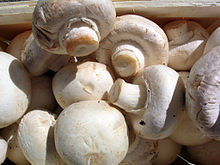
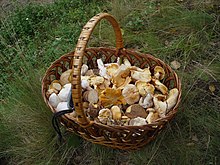
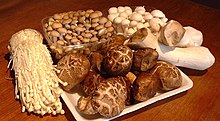
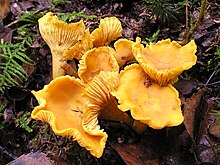



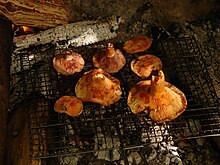

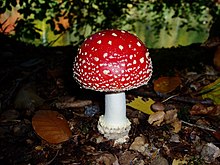



No comments:
Post a Comment
Jayant Parkash Is Welcome All world to my blog